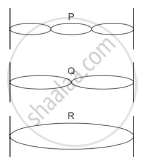Advertisements
Advertisements
Question
Solution
Give that, speed of sound at 0° = 330 m/s
For every 1° rise in temperature, the velocity of sound increases by 0.61 m/s
`therefore` the velocity of sound at 10° = 330 + (0.61 x 10) = 330 + 6.1 = 336.1 m/s
Let A1 and A2 be the distances of the two walls from the point of refile shots. Thhen
2 x A1 = 336.1 x 3 = 1008.3 ...................(i)
2 x A2 = 336.1 x 6 = 2016.6 ...................(ii)
Adding (i) and (ii) we get
2 (A1 + A2) = 3024.9
or, (A1 + A2) = 1512.45 m
Thus the width of the velley is 1512.45 m
APPEARS IN
RELATED QUESTIONS
In the diagram below, A, B, C, D are four pendulums suspended from the same elastic string PQ. The length of A and C are equal to each other while the length of pendulum B is smaller than that of D. Pendulum A is set into a mode of vibrations

1) Name the type of vibrations taking place in pendulums B and D?
2) What is the state of pendulum C?
3) State the reason for the type of vibrations in pendulum B and C.
The adjacent diagram shows three different modes of vibrations P, Q and R of the same string.

(i) Which vibration will produce a louder sound and why?
(ii) The sound of which string will have maximum shrillness?
(iii) State the ratio of wavelengths of P and R.
How does the medium affect the amplitude of free/natural vibrations of a body?
Describe a simple experiment to illustrate the phenomenon of resonance and explain it.
In following figure shows two tuning forks A and B of the same frequency mounted on two separate sound boxes with their open ends facing each other. The fork A is set into vibration.
- Describe your observation.
- State the principle illustrated by this experiment.

Name the phenomenon involved in tuning your radio set to a particular station and define it.
On keeping the stem of a vibrating tuning fork on the surface of a table, a loud sound is heard. Give reason.
A bucket kept under a running tap is getting filled with water. A person sitting at a distance is able to get an idea when the bucket is about to be filled.
(i) What change takes place in the sound to give this idea?
(ii) What causes the change in the sound?
What do you understand by free vibrations of a body? Draw a displacement-time graph to represent them. Given one example.
